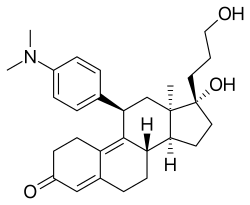Onapristone
Onapristone (INN) (developmental code names ZK-89299, ZK-299) is a synthetic and steroidal antiprogestogen with additional antiglucocorticoid activity which was developed by Schering[1] and described in 1984 but was never marketed.[2][3] It is a silent antagonist of the progesterone receptor (PR), in contrast to the related antiprogestogen mifepristone (which is a weak partial agonist of the receptor).[4] Moreover, compared to mifepristone, onapristone has reduced antiglucocorticoid activity, shows little antiandrogenic activity, and has 10- to 30-fold greater potency as an antiprogestogen.[4] The medication was under development for clinical use, for instance in the treatment of breast cancer and as an endometrial contraceptive, but was discontinued during phase III clinical trials in 1995 due to findings that liver function abnormalities developed in a majority patients.[5][6][7]
 | |
| Clinical data | |
|---|---|
| Other names | ZK-89299; ZK-299; AR-18; IVV-1001; 11β-(4-(Dimethylamino)phenyl)-17α-hydroxy-17β-(3-hydroxypropyl)-13α-estra-4,9-dien-3-one |
| Drug class | Antiprogestogen |
| Identifiers | |
IUPAC name
| |
| CAS Number | |
| PubChem CID | |
| ChemSpider | |
| UNII | |
| KEGG | |
| ChEMBL | |
| CompTox Dashboard (EPA) | |
| ECHA InfoCard | 100.233.493 |
| Chemical and physical data | |
| Formula | C29H39NO3 |
| Molar mass | 449.635 g·mol−1 |
| 3D model (JSmol) | |
SMILES
| |
InChI
| |
Onapristone has been found to be effective in the treatment of breast cancer.[8][5][9]
As of 2016, onapristone has re-emerged and is under development for the treatment of prostate cancer, currently in phase II clinical trials.[10] It was also under development for the treatment of endometrial cancer, breast cancer, ovarian cancer, and uterine cancer, but was discontinued for these indications in favor of focusing on prostate cancer.[10]
See also
References
- Lev M. Berstein; Richard J. Santen (4 December 2009). Innovative Endocrinology of Cancer. Springer Science & Business Media. pp. 102–. ISBN 978-0-387-78818-0.
- J. Elks (14 November 2014). The Dictionary of Drugs: Chemical Data: Chemical Data, Structures and Bibliographies. Springer. pp. 903–. ISBN 978-1-4757-2085-3.
- I.K. Morton; Judith M. Hall (31 October 1999). Concise Dictionary of Pharmacological Agents: Properties and Synonyms. Springer Science & Business Media. pp. 207–. ISBN 978-0-7514-0499-9.
- Edward J. Pavlik (6 December 2012). Estrogens, Progestins, and Their Antagonists: Health Issues. Springer Science & Business Media. pp. 134–. ISBN 978-1-4612-4096-9.
- Robertson JF, Willsher PC, Winterbottom L, Blamey RW, Thorpe S (February 1999). "Onapristone, a progesterone receptor antagonist, as first-line therapy in primary breast cancer". Eur. J. Cancer. 35 (2): 214–8. doi:10.1016/S0959-8049(98)00388-8. PMID 10448262.
- Katkam RR, Gopalkrishnan K, Chwalisz K, Schillinger E, Puri CP (1995). "Onapristone (ZK 98.299): a potential antiprogestin for endometrial contraception". Am. J. Obstet. Gynecol. 173 (3 Pt 1): 779–87. PMID 7573244.
- Ismail Jatoi; Manfred Kaufmann (11 February 2010). Management of Breast Diseases. Springer Science & Business Media. pp. 338–. ISBN 978-3-540-69743-5.
- Klijn JG, Setyono-Han B, Foekens JA (2000). "Progesterone antagonists and progesterone receptor modulators in the treatment of breast cancer". Steroids. 65 (10–11): 825–30. doi:10.1016/S0039-128X(00)00195-1. PMID 11108894.
- Cottu PH, Bonneterre J, Varga A, Campone M, Leary A, Floquet A, Berton-Rigaud D, Sablin MP, Lesoin A, Rezai K, Lokiec FM, Lhomme C, Bosq J, Bexon AS, Gilles EM, Proniuk S, Dieras V, Jackson DM, Zukiwski A, Italiano A (2018). "Phase I study of onapristone, a type I antiprogestin, in female patients with previously treated recurrent or metastatic progesterone receptor-expressing cancers". PLoS ONE. 13 (10): e0204973. doi:10.1371/journal.pone.0204973. PMC 6179222. PMID 30304013.
- "Onapristone - Context Therapeutics". Adis Insight.